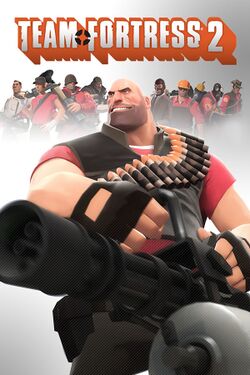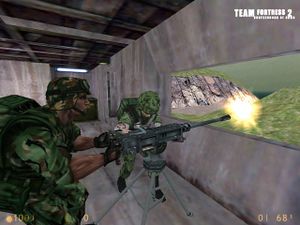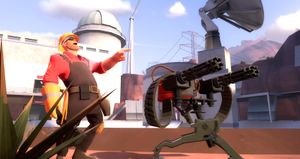Team Fortress 2
| Diese Seite wird zurzeit auf Deutsch übersetzt. Wenn du Deutsch sprichst, poste bitte auf die Diskussionsseite oder sprich mit denen, die zu dieser Seite beigetragen haben (zu finden in der Versionsgeschichte). |
| Team Fortress 2 | |
|---|---|

| |
| Informationen | |
| Erschienen: |
|
| Entwickler: | |
| Herausgeber: | |
| Verkauf: |
EA Distribution/Steam |
| Engine: | |
| Genre: |
First-person shooter |
| Modi: |
Multiplayer |
| Designer: |
John Cook, Robin Walker |
| Einstufung: |
|
| Platformen: |
Windows, Xbox 360, PlayStation 3, Mac |
| Media: |
Download, DVD, Blu-ray disc |
| Voraussetzungen: |
|
Team Fortress 2 ist ein teambasierter Multplayer-FPS-Shooter von Valve, und erschien als Teil der Orange Box. Er erschien für Microsoft Windows, Xbox 360 und PlayStation 3 im Jahr 2007, und als Stand-Alone im Jahr 2008.
Das Spiel wurde im Jahr 1998 als Nachfolger zu der Team Fortress-Mod für Quake angekündigt, hat aber seitdem mehrere Konzeptwandlungen und Designänderungen durchgemacht. Im Jahr 1999 zeigte Valve, das das Spiel sich vom echten Team Fortress und Valves eigener Team Fortress Classic-Modifikation für Half-Life unterscheidet, indem es einen realistischeren und militärischen Spielstil besitzt, aber dieses Konzept veränderte sich in der neunjährigen Entwicklungszeit und dem Engine-Wechsel immer mehr. Das endgültige Team Fortress 2 ähnelt eher dem ersten Team Fortress und Team Fortress Classic, und nutzt einen Cartoon-ähnlichen Stil, basierend auf der Kunst von J. C. Leyendecker, Dean Cornwell und Norman Rockwell, wobei das Spiel dem populärem Trend neuer CGI-Filme folgt (genau gesagt, Filme von Pixar/Disney, wie Die Unglaublichen).
Das Fehlen von neuen Informationen oder Hinweise für Fortschritte in den 6 Entwicklungsjahren sorgte dafür, dass das Spiel als Vaporware abgestempelt wurde, und war häufig in den Wired News jährlicher Vapoware-Liste vertreten. Das Spiel erhielt von der Presse großen Beifall und wurde seit dem Erscheinen mit mehreren Awards ausgezeichnet.
Inhaltsverzeichnis
Gameplay
Wie seine Vorgänger stehen in Team Fortress 2 zwei feindliche Teams gegenüber, die beide eine Aufgabe erreichen wollen. Beide Teams repräsentieren auf der einen Seite eine Abriss-, auf der anderen Seite eine Baufirma: Reliable Excavation Demolition (Rot) and Builders League United (Blau). Spieler können als eine von 9 Klassen in diesen Teams spielen, jede mit ihren einzigartigen Stärken und Schwächen. Obewohl die Fähigkeiten mancher Klassen sich von früheren Team Fortress-Spielen unterschieden, haben die Basiselemente jeder Klasse überlebt.
Team Fortress 2 ist das erste Multiplayerspiel von Valve, dass detaillierte Statistiken über die Spieler sammelt. Diese Statistiken führen auf, wie lange der Spieler als eine bestimmte Klasse gespielt hat, wie hoch seine durchschnittliche Punktzahl ist und die durch ihn erfolgten Eroberungen oder erfüllten Ziele in einer Runde (siehe Valve-Statistiken. Die Statistiken erläutern dem Spieler, wie er sich in Bezug auf die abgespeicherten Statistiken verbessert hat, wie beispielsweise, wenn ein Spieler seinem Rekord für ausgeteilten Schaden in einer Runde nahekommt. Team Fortress 2 besitzt außerdem unzählige Errungenschaften für das Erfüllen bestimmter Aufgaben, wie eine bestimmte Anzahl an Kills in einer kurzen Zeit oder eine Runde in einer bestimmten Zeit zu beenden. Neue klassenspezifische Errungenschaften wurden in späteren Updates hinzugefügt, die neue Fähigkeiten und Waffen für jede Klasse hinzufügen, die durch den Spieler freigeschaltet werden können. Erlangte Errungenschaften und Statistiken von vorherigen Spielen werden auf der Steam-Community-Seite des Spielers oder dessen Xbox Live-Seite angezeigt.
Karten
Hauptartikel: Karten
Mit der PC-Version wird das Spiel mit einer Reihe von offiziellen Karten von Valve ausgeliefert, gemeinsam mit mehreren von der Community hergestellten Karten. Auf den Konsolenversionen jedoch gibt es nur 5 offiziellen Karten von Valve. Die offiziellen Karten folgen einer Mentalität, bei der hinter allem ein böses Genie steckt, mit geheimen Untergrundbasen, versteckt in Warenhäusern, und übertrieben großen Super-Waffen, wie Laserkanonen und Raketenanlagen als Zielen.
Wenn Spieler eine Karte das erste mal spielen, zeigt ihnen ein Einführungsvideo, wie die Ziele erreicht werden können. Das Spielerlimit am PC beträgt 24, obwohl das Spielerlimit angehoben wurde, um 32 Spieler gemeinsam spielen zu lassen, bei der Xbox 360- und Playstation 3-Version sind es aber nur 16.
Entwicklung
Herkunft
Anfangs noch als kostenlose Modifikation für Quake geplant, wechselte Valve bei der Entwicklung von Team Fortress 2 auf die GoldSrc-Engine im Jahr 1998, nach dem das Entwicklerteam Team Fortress Software - bestehend aus Robin Walker und John Cook - unter Vertrag genommen wurde und die Mitarbeiter schließlich bei Valve fest angestellt wurden.
Zum Zeitpunkt der Übernahme von Team Fortress Software hat die Produktion einen Zahn zugelegt und wurde zu einem selbstständigen Spiel erklärt. Viele Spieler hatten bereits Half-Life gekauft, einzig und allein aus Vorfreude über die kostenlose Veröffentlichung von Team Fortress 2. Die Arbeit begann an einer simplen Portierung des 1999 kostenlos erschienenen Team Fortress Classic. Team Fortress Classic wurde komplett mit dem öffentlich erhältlichen Half-Life Software Development Kit erstellt um der Community und der Industrie seine Flexibilität zu zeigen.
Walker und Cook wurden von der dreimonatigen Vertraglichen Arbeit bei Valve stark beeinflusst und nun arbeiteten sie Vollzeit an ihrem Design, welches eine schnelle Verwandlung durchmachte. Team Fortress 2 sollte ein modernes Kriegsspiel mit einer Kommando-Hierarchie inkl. Kommandant mit Vogelperspektive über dem Schlachtfeld, Fallschirmabwürfen über feindlichem Gebiet, Sprachkommunikation über Netzwerk und zahlreichen anderen Innovationen werden.
E3 1999
The new design was revealed to the public at the 1999 Electronic Entertainment Expo (E3), where it earned several awards including Best Online Game and Best Action Game. By this time Team Fortress 2 had gained a new subtitle, Brotherhood of Arms, and the results of Walker and Cook working at Valve were becoming clear. Several new and at the time unprecedented technologies on show: Parametric animation seamlessly blended animations for smoother, more life-like movement, and Intel's Multi-resolution mesh technology dynamically reduced the detail of on-screen elements as they became more distant to improve performance (a technique made obsolete by decreasing memory costs; today games use a technique known as level of detail, which uses more memory but less processing power). No release date was given at the exposition.
In mid-2000, Valve announced that development of Team Fortress 2 had been delayed for a second time. They put the news down to development switching to an in-house, proprietary engine that is today known as the Source engine. It was at around this time that all news ran dry and Team Fortress 2 entered its notorious six-year radio silence, which was to last until July 13, 2006. During that time, both Walker and Cook worked on various other Valve projects—Walker was project lead on Half-Life 2: Episode One and Cook became a Steam developer, among other tasks—raising doubts that Team Fortress 2 was really the active project that would be repeatedly described.
"Invasion" design
When the Half-Life 2 source tree was leaked in late 2003, two Team Fortress 2 models were included, along with direct references to the game in the source code. They consisted of an alien grunt and a very stylized, out-of-proportion human soldier. The code was interpreted by fans as making references to the Seven Hour War, an integral part of the Half-Life story; however, the two leaked player models did not look Combine or human.
The Source SDK was released with the Half-Life 2 source code, and also provided references to the game. Some code merely confirmed what was already believed, but other segments provided completely new information, such as the presence of NPCs in multiplayer matches, the possibility of the game taking place in the Half-Life 2 universe, fixed plasma gun and missile launcher emplacements, and more.
None of the leaked information appears to have had any bearing on today's version of the game. This iteration was mentioned in an August 2007 interview with Gabe Newell by GameTrailers, in which he mentions "Invasion" as being the second-phase of Team Fortress 2's development under Valve Software.
Final design
The next significant public development occurred in the run up to Half-Life 2's 2004 release: Valve's Director of Marketing Doug Lombardi claimed that Team Fortress 2 was still in development and that information concerning it would come after Half-Life 2's release. This did not happen; nor was any news released after Lombardi's similar claim during an early interview regarding Half-Life 2: Episode One. Near the time of Episode One's release Gabe Newell again claimed that news on Team Fortress 2 would be forthcoming— and this time it was. Team Fortress 2 was re-unveiled a month later at the July 2006 EA Summer Showcase event.
Walker revealed in March 2007 that Valve had quietly built "probably three to four different games" before settling on their final design. Due to the game's lengthy development cycle it was often mentioned alongside Duke Nukem Forever, another long-anticipated game that has seen many years of protracted development and engine changes.
The beta release of the game featured six multiplayer maps, of which three contain optional commentary by the developers on the game design, level design and character design, and provide more information on the history behind the development.
Team Fortress 2 does not attempt the realistic graphical approach used in other Valve games on the Source engine such as Half-Life 2, Day of Defeat: Source and Counter-Strike: Source. Rather, it uses a more stylized, cartoon-like approach "heavily influenced by early 20th century commercial illustrations.". The effect is achieved using a special Valve in-house rendering and lighting technique making extensive use of 'Phong shading'. The development commentary in the game suggests that part of the reason for the cartoonish style was the difficulty in explaining the maps and characters in realistic terms. The removal of an emphasis on realistic settings allows these questions to be sidestepped. The game debuts with the Source engine's new dynamic lighting, shadowing and soft particle technologies, among many other unannounced features, alongside Half-Life 2: Episode Two. Team Fortress 2 was also the first game to implement the Source engine's new Facial animation 3 features.
The art style for the game was inspired by J. C. Leyendecker, as well as Dean Cornwell and Norman Rockwell. Their distinctive styles of strong silhouettes and shading to draw attention to specific details were adapted in order to make the models distinct, with a focus on making the characters' team, class and current weapon easily identifiable. Silhouettes and animation are used to make the class of a character apparent even at range, and a color scheme that draws attention to the chest area brings focus to the selected weapon.
Maps are designed with a neutral space between two bases. They are archetypal spy fortresses, but disguised as inconspicuous buildings to give plausibility to their close proximities. The maps have little visual clutter and stylized, almost impressionistic modeling, to allow enemies to be spotted more easily. The impressionistic design approach also affects textures, which are based on photos that are filtered and improved by hand, giving them a tactile quality and giving Team Fortress 2 its distinct look. The bases are designed to let players immediately know where they are. The RED base uses warm colors, natural materials and angular shapes, while the BLU base uses cool colors, industrial materials and orthogonal shapes.
Release
During the July 2006 Electronic Arts press conference, Valve revealed that Team Fortress 2 would ship as the multiplayer component of Half-Life 2: Episode Two. A conference trailer demonstrated the game's new graphical style featuring all of the original Team Fortress classes, pointed towards a more light-hearted and whimsical visual style as opposed to the dark, somewhat more traditional military simulation that had originally been shown. Gabe Newell, the managing director of Valve, said that their goal was to create "the best looking and best-playing class-based multiplayer game."
A beta for Team Fortress 2 was released via Steam on September 17 2007 for customers who pre-purchased The Orange Box and for those who activated their Black Box coupon, which was included with the ATI HD 2900XT Graphics cards. In addition to The Orange Box customers, LAN gaming centers using the 'Steam for Cafe' system have the game installed and ready to play.
Team Fortress 2 was released October 10 2007 as both a standalone product via Steam and at retail stores as part of The Orange Box, a compilation pack priced at each gaming platform's standard price. The package also contains Half-Life 2, Half-Life 2: Episode One, Half-Life 2: Episode Two and Portal. Valve offered The Orange Box at a $5 discount for those who pre-purchased it via Steam before the October 10 release, as well as the opportunity to participate in the final beta test of Team Fortress 2.
Critical reception
- 1UP: 9.0/10 (Windows) 1UP TF2 (Win) Review)
- EuroGamer: 9/10 (Windows) EuroGamer TF2 (Win) Review)
- GameSpy: 5/5 (Windows) GameSpy TF2 (win) Review)
- IGN: 8.9/10 (Windows)
- PCGamer UK: 9.4/10 (Windows) PC Gamer UK TF2 (WIN) Review)
- GamerNode: 9.0/10 (Windows) Gamernode TF2 (Win) Review)
- GameDaily: 9.0/10 (Windows) GameDaily TF2 (Win) Review)
- Metacritic: 92% (Windows)
- Gamerankings: 96.2% (Windows) 96.1% (Xbox 360) 87.7% (PlayStation 3)
Team Fortress 2 was very well received by critics and consumers alike. Charles Onyett of IGN awarded Team Fortress 2 an 8.9/10, praising the quirky graphics and fun atmosphere, but criticizing the lack of extra content, like bots, as well as the removal of class-specific grenades, which were one of the defining features of the original Team Fortress. By contrast, PC Gamer UK praised Team Fortress 2 for removing the grenades, continuing to compliment Valve Software for the unique nature of each of the game's characters. Despite some mild criticism over map navigation and the Medic class, PC Gamer UK awarded the game 94%. X-Play awarded The Orange Box with its highest rating (5/5) with nothing but good things to say about Team Fortress 2. Review aggregation site Metacritic ranks Team Fortress 2 as having received "universal acclaim", with an average critic review of 92%, based on 12 reviews by game critic sites, and a 9.6/10 rating based on user ratings. As of January 21, 2008, The Orange Box has a GameRankings score of 96.2% on the Xbox 360, making it tied for the the highest ranked Xbox 360 game, and a score of 96.2% on the PC.
Awards
Team Fortress 2 has won several awards since its release. In its "Best of 2007" awards, IGN.com honored the game with an award for "Best Artistic Design" for PC. Additionally, Team Fortress 2 received awards for "Best Multiplayer Experience (PC)" and "Best Artistic Direction (PC)" from 1UP.com in its 2007 editorial awards. The game also won "Best Multiplayer Game of the Year" both on PC and on any platform in GameSpy's 2007 Game of the Year awards along with an award for "Most Unique Art Style".
External links
- The Team Fortress 2 page at the official site of The Orange Box.
- Valve Software official site.
- The Official Team Fortress 2 Blog
Major game updates (oldest to newest):
- The Gold Rush Update
- The Pyro Update
- A Heavy Update
- The Scout Update
- The Sniper vs. Spy Update
- Classless Update
- Hallowe'en Special
- WAR! Update
- 119th Update
- The Mac Update
- The Engineer Update
- The Mann-Conomy Update
| Sprachen: | English · dansk · Deutsch · español · suomi · français · italiano · 日本語 · 한국어 · Nederlands · norsk · polski · português · português do Brasil · русский · svenska · Türkçe · 中文(简体) |



